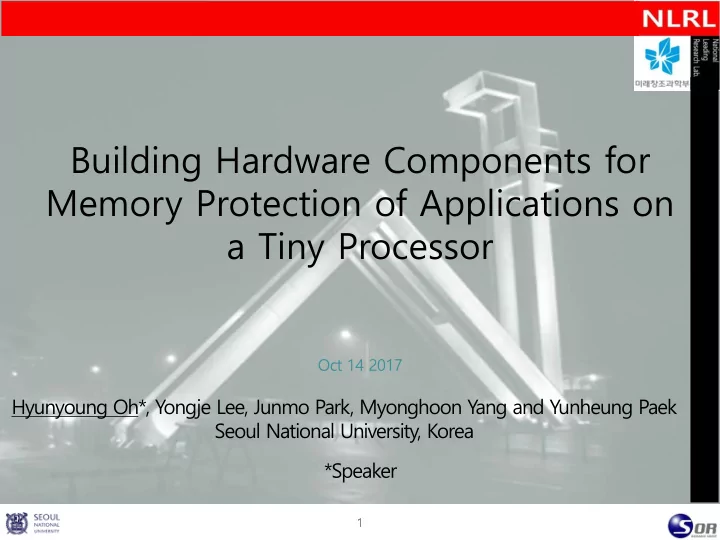

Building Hardware Components for Memory Protection of Applications on a Tiny Processor Oct 14 2017 Hyunyoung Oh*, Yongje Lee, Junmo Park, Myonghoon Y ang and Yunheung Paek Seoul National University, Korea *Speaker 1
Security Optimization Research Lab. Outline Motivation Our Goal Overall Architecture Implementation Details § Security Interface § Memory Region Protector § Access Permission Matrix Experimental Results § Area Overhead § Performance Consideration Conclusion 2
Security Optimization Research Lab. Motivation In IoT era… § More and more small devices with Tiny processors § More sensitive user information § Memory protection is a conventional defense § Virtual memory cannot be applied due to high complexity Then How to Protect Memory? § MPU (memory protection unit in ARM) [3] - reconfigured in order to constrain different access permissions for every process § SMART [4] - is a new processor architecture including a special § TrustLite [7] - links code regions to data regions requires intrusive modification of an existing processor 3
Security Optimization Research Lab. Motivation In IoT era… § More and more small devices with Tiny processors § More sensitive user information § Memory protection is a conventional defense § Virtual memory cannot be applied due to high complexity Then How to Protect Memory? § MPU (memory protection unit in ARM) [3] - Inefficient § SMART [4], TrustLite [7] - Invasive and permanent modification of the existing host processor 4
Security Optimization Research Lab. Our Goal Secure and efficient memory protection mechanism § Minimize OS’s role § Configure just once at the boot phase Less design change of the host processor § Conform to the modular design approach § Several hardware components can be assembled together 5
Security Optimization Research Lab. Overall Architecture RISC-V CPU Memory Access Security Region Permission Interface Protector Matrix AMBA Interconnect (Master/Slave) Memory Main Controller Memory 3 Main Hardware Components § Security Interface § Memory Region Protector § Access Permission Matrix 6
Security Optimization Research Lab. Implementation Details Security Interface § Just connecting wires Core EX Stage MEM Stage WB Stage Security Interface § Extracting inst_addr, EX_pc WB_pc MEM_pc inst_addr MUX data_type, data_addr EX ctrl data_type reg § Synchronizing these 3 data_addr Address signals MUX Store Load extender Address Arb D § By referring EX data_en control register Load Store Tagged Address Existing wire Data Array Additional wire Data Cache 7
Security Optimization Research Lab. Implementation Details Memory Region Protector § CRS/DRS classify the Access Permission Matrix region indexes for the current instruction § Access Permission Memory Region Protector Matrix provides the Code Region Selector Data Region Selector legitimate code_region_ Decision Unit num data_region_ num permission for those code_region_ num_t indexes § Decision Unit checks inst_addr, set code regions MRP Controller whether the data_addr data_addr set data regions AHB Slave Interface signals from security interface permission is violated or not AHB Interconnect 8
Security Optimization Research Lab. Implementation Details Access Permission Matrix § Has the access permission for code and data regions § Check code-code access as well as code-data access § Any access not permitted in the matrix will be illegal 9
Security Optimization Research Lab. Experimental Results Area Overhead § Xilinx Zynq-7000 board § Version 1.7 of RISC-V Rocket core with DefaultFPGASmallConfig Category Components LUTs FFs Baseline Rocket Core 9229 6894 System Security Interface 80 195 Our Memory Region Protector 1066 1082 Hardware Access Permission Matrix 36 204 Components Total 1182 1481 % over Baseline System 12.81% 21.48% § 16.5% over baseline system in LUTs+FFs § Memory Region Protector occupies 80% area within our total ß due to region boundary registers and selecting muxes 10
Security Optimization Research Lab. Performance Consideration Performance Overhead § Security Interface - Just probes wires so that incurs no impact to the critical path of the host CPU - Zero impact § Memory Region Protector - Runs in parallel with the functional execution of the host - Zero impact § Access Permission Matrix - In tiny processors, most applications are already fixed - Code/data region boundaries and their permission can be statically allocated - Negligible impact on the whole system performance 11
Security Optimization Research Lab. Conclusion Proposed Hardware Components § Memory Region Protector is the core component § This refers Access Permission Matrix § Security Interface extracts PC and memory target address Low Overheads § Low area overhead and near zero performance overhead More Flexible § In MPU [3] and PMP [5], region can be configured as a power-of- two multiple of 4KB § But we can set the boundaries by arbitrary addresses § Moreover, CPU internal information extracted through Security Interface can be used for various hardware based security mechanisms 12
Security Optimization Research Lab. Q&A Thank You Hyunyoung Oh (hyoh@sor.snu.ac.kr) - 2007~2017: RTL Engineer in Samsung Electronics - 2017~ : Pursuing PhD in Seoul National University Prof. Yunheung Paek is supervisor 13
Recommend
More recommend